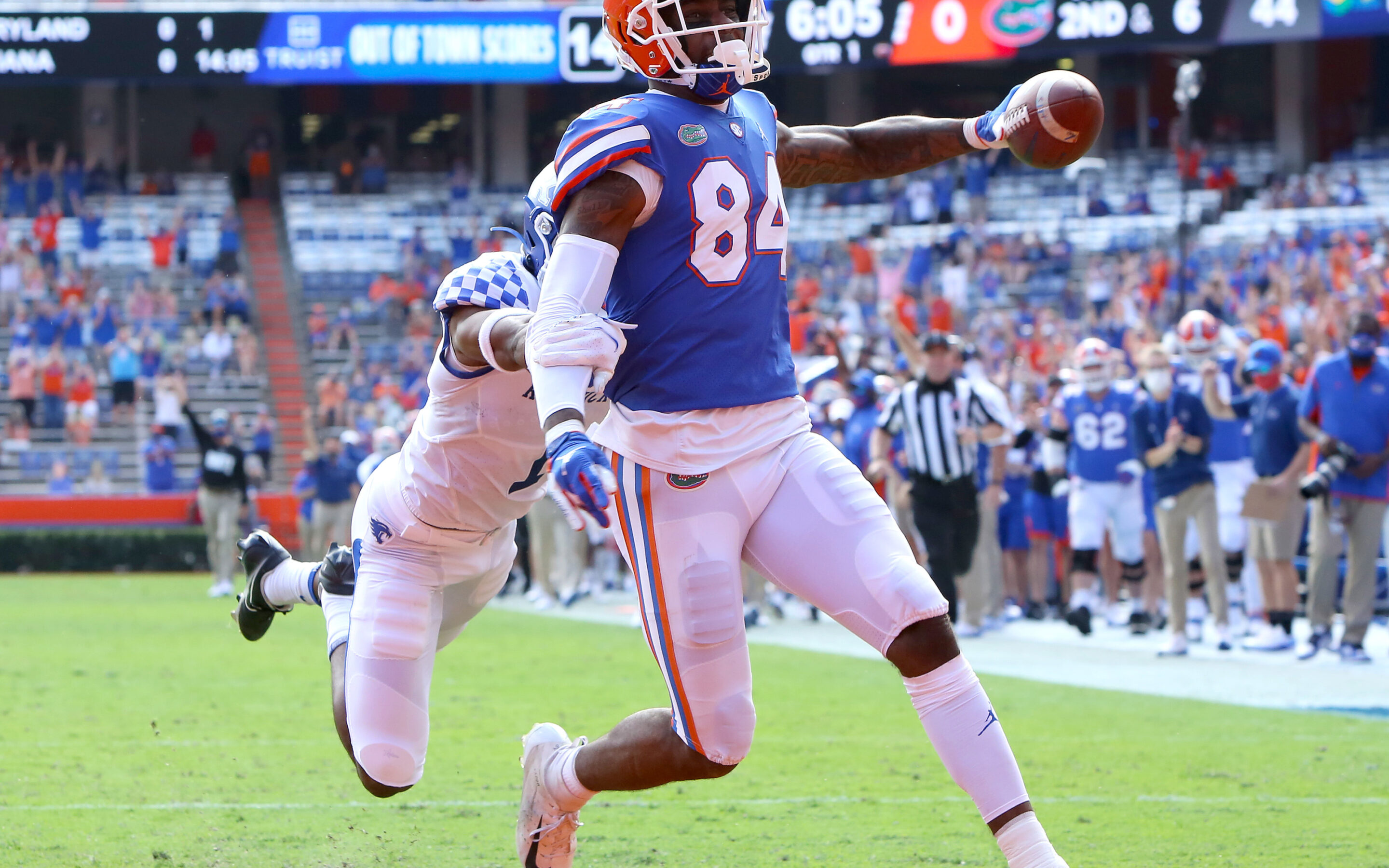For nine outstanding seasons, Greg Olsen was the Panthers’ undisputed #1 tight end. A status he earned by being one of the best tight ends of his generation, and one of the best players in franchise history. Whatever the Panthers needed – A big play down the field, tough yards for a first down, savviness in the red zone, the dirty work of blocking – Olsen was always there to provide it. While it wasn’t always flashy, Olsen’s reliability was a central part of his game.
“I took great pride in that Cam Newton, when he looked across from me in the huddle to call the play, that Cam Newton would go ‘I can trust this guy. I’m glad he’s here, we’re better off that he’s in the huddle than if he wasn’t.’ That was my greatest sense of pride,” said Olsen in March. “… I wanted Cam to feel, when he needed a guy, that he could look across the huddle and be like ‘He’s here, I’ve got him.’”
However, while all those years of elite tight end play might have been taken for granted at times, Olsen’s absence from the huddle is certainly being noticed now. While he has moved on to his next chapter following a retirement ceremony back in Carolina last month, the Panthers are still looking for their next stalwart tight end.
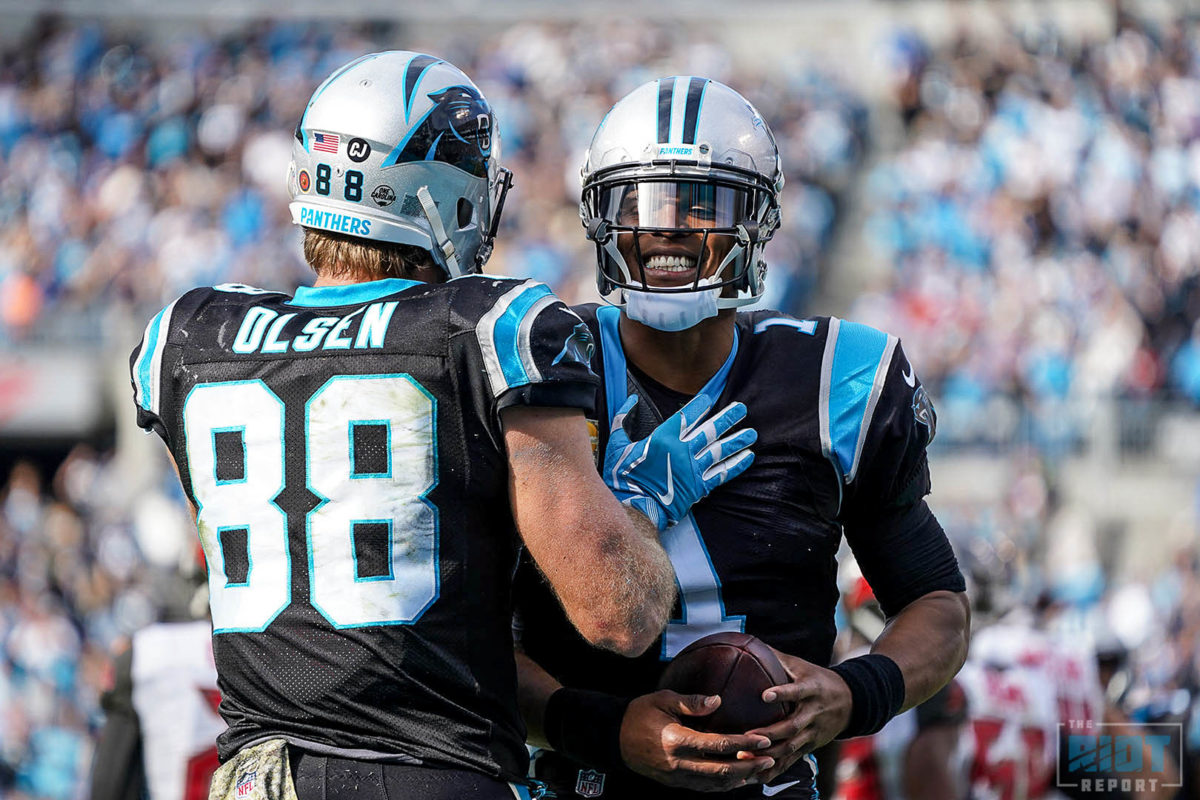
For as much statistical production as Carolina’s offense got out of their running backs and receivers in 2020, the same was not true for the tight ends. Despite getting his opportunity to step into that #1 role, Ian Thomas made little impact with just 20 catches for 145 yards and a touchdown. Chris Manhertz excelled as a blocker but saw only limited opportunities in the receiving game (Six receptions, 52 yards) while Colin Thompson’s lone statistical contribution was a seven-yard touchdown grab.
Prior to the start of free agency, Matt Rhule signaled that adding to the tight end room would be a priority for the offseason, and this desire has likely only been compounded by Manhertz’s departure to Jacksonville. The addition of Dan Arnold in free agency, who had a breakout season with the Arizona Cardinals in 2020, was a start, but the Panthers will likely be keen to add further at the position in the draft.
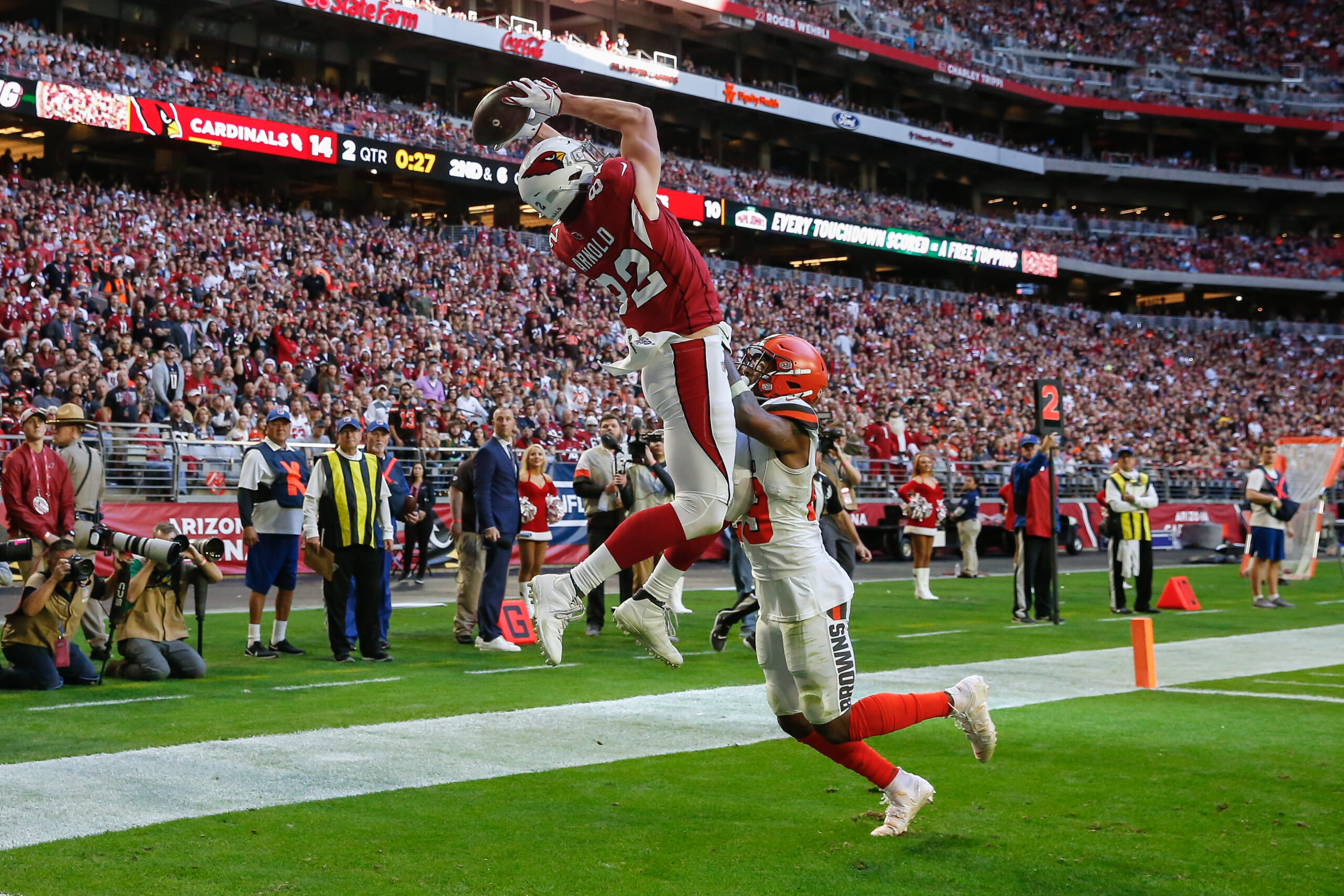
GLENDALE, AZ – DECEMBER 15: Arizona Cardinals tight end Dan Arnold (82) catches a touchdown pass during the NFL football game between the Cleveland Browns and the Arizona Cardinals on December 15, 2019 at State Farm Stadium in Glendale, Arizona. (Photo by Kevin Abele/Icon Sportswire via Getty Images)
While it’s hard to know how the draft will play out for any team not holding the #1 pick, tight end is towards the top of the Panthers’ to-do list, though speaking to the media Matt Rhule indicated that even if tight one is one of their bigger needs, it might not be a direction that history suggests should be a target early on:
“You go study the top receiving tight ends in the National Football League, and guys who get taken in the first round – Some of them work out, some don’t. Some of the best tight ends are third round guys, fifth round guys,” said Rhule last month. “It’s something that you just have to find the right guy that fits you.”
However, before getting into the details of what the Panthers’ approach at the position might be, it’s worth taking a moment to consider what impact a good receiving tight end can have.
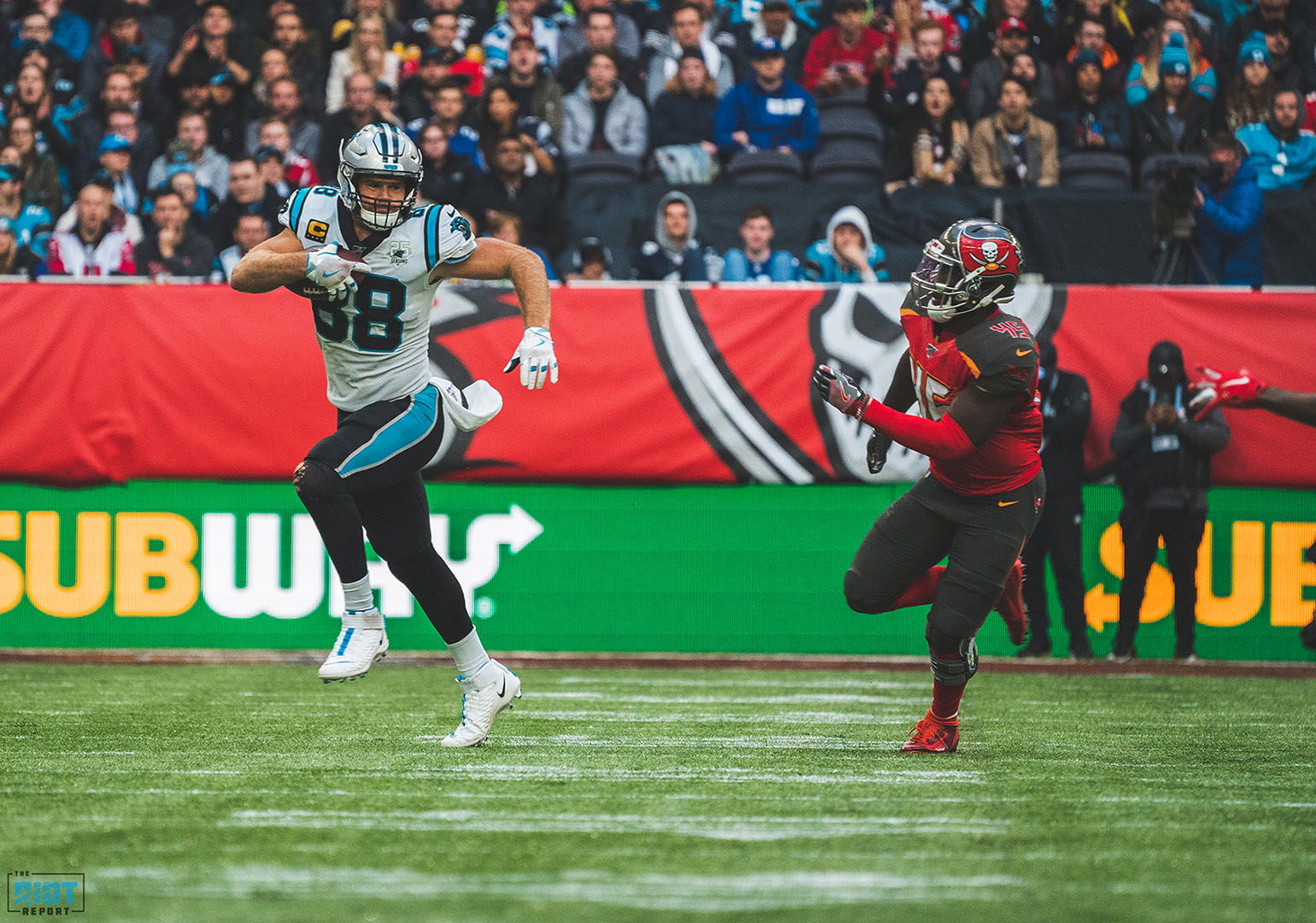
From a schematic perspective, great receiving tight ends place enormous stress on defenses, and high-quality blockers can also be difference-makers in the run game. From a roster-building standpoint, top tight ends are also much more cost-effective towards the salary cap than, say, a wide receiver or a running back. According to Spotrac, only a third of NFL teams have $10 million or more in salary cap space devoted to tight ends, with no team incurring a cap hit of more than $17.5 million for the position (though the Patriots are due to smash this ceiling in 2022 with almost $30 in TE spending).
It should be no surprise, then, that the teams that have made it to the Super Bowl in recent years have featured some of the best tight ends in football: Travis Kelce of the Kansas City Chiefs, George Kittle of the San Francisco 49ers, Rob Gronkowski of the New England Patriots & Tampa Bay Buccaneers among them.
For the Panthers then, finding somebody who can get close to replicating Olsen’s contribution could be a major building block in taking them where they want to go in the Matt Rhule/Scott Fitterer era.
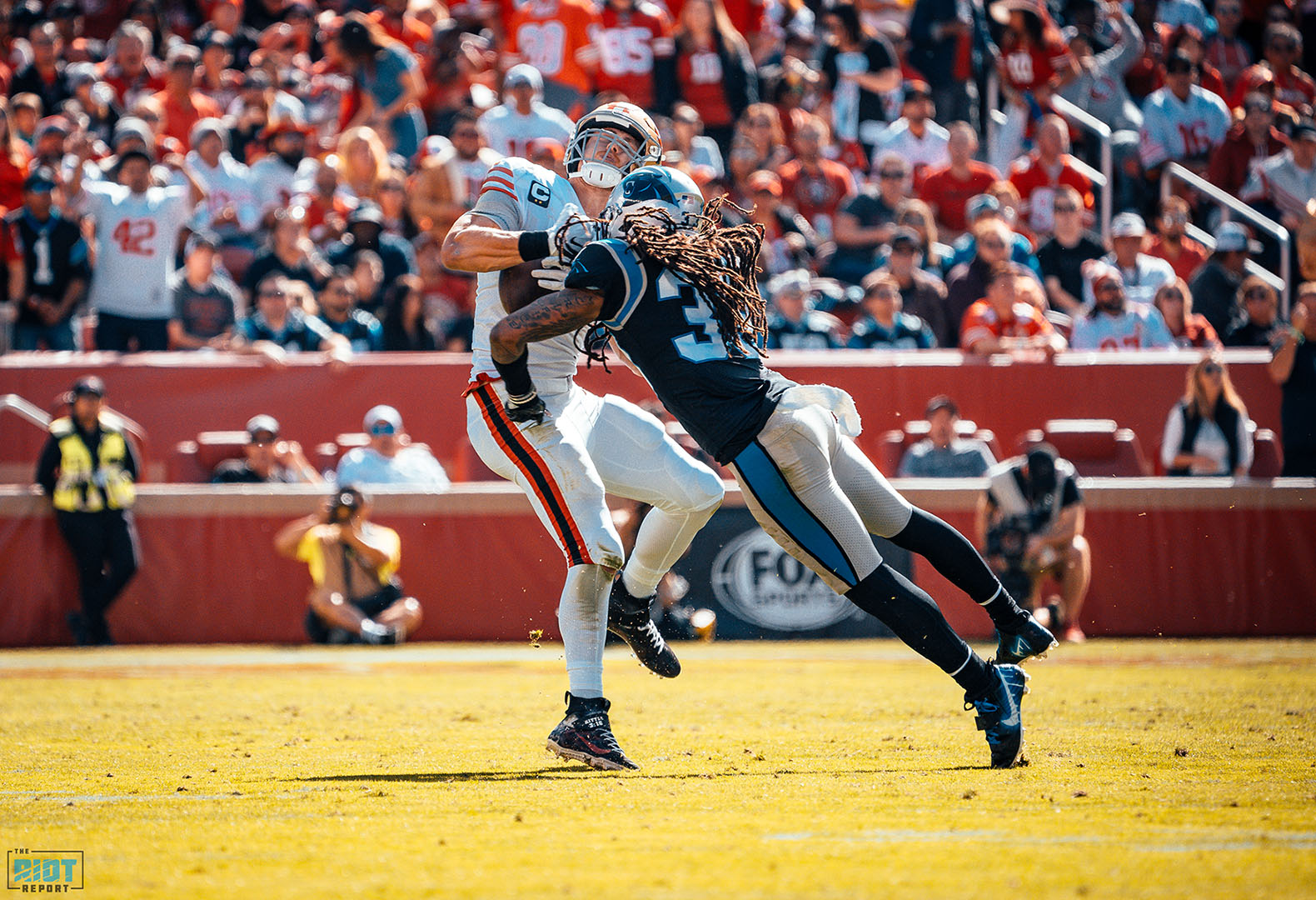
In terms of tight ends in the 2021 NFL Draft, there has been considerable hype around Kyle Pitts, who is widely considered to be the best tight end in the class. While he has been mocked as high as the fourth pick, there is a chance that Pitts could be on the board when the Panthers pick, and he is somebody the Panthers are definitely doing their homework on. Matt Rhule was in attendance for his Pro Day, and Pitts told the media that he and Rhule have already spoken “multiple times”.
<iframe width=”560″ height=”315″ src=”https://www.youtube.com/embed/khgTYEv2PHA” title=”YouTube video player” frameborder=”0″ allow=”accelerometer; autoplay; clipboard-write; encrypted-media; gyroscope; picture-in-picture” allowfullscreen></iframe>
With exceptional speed and hands to go with a 6-foot-5 and 245 pound frame, Pitts has been hailed as a “unicorn” and a potential elite tight end in the NFL, and certainly doesn’t lack for potential. If the Panthers are going to select a tight end in the first round it will almost certainly be Pitts, but it is worth looking a bit deeper at Matt Rhule’s comment about some of the best tight ends not being selected in the first round of the draft.
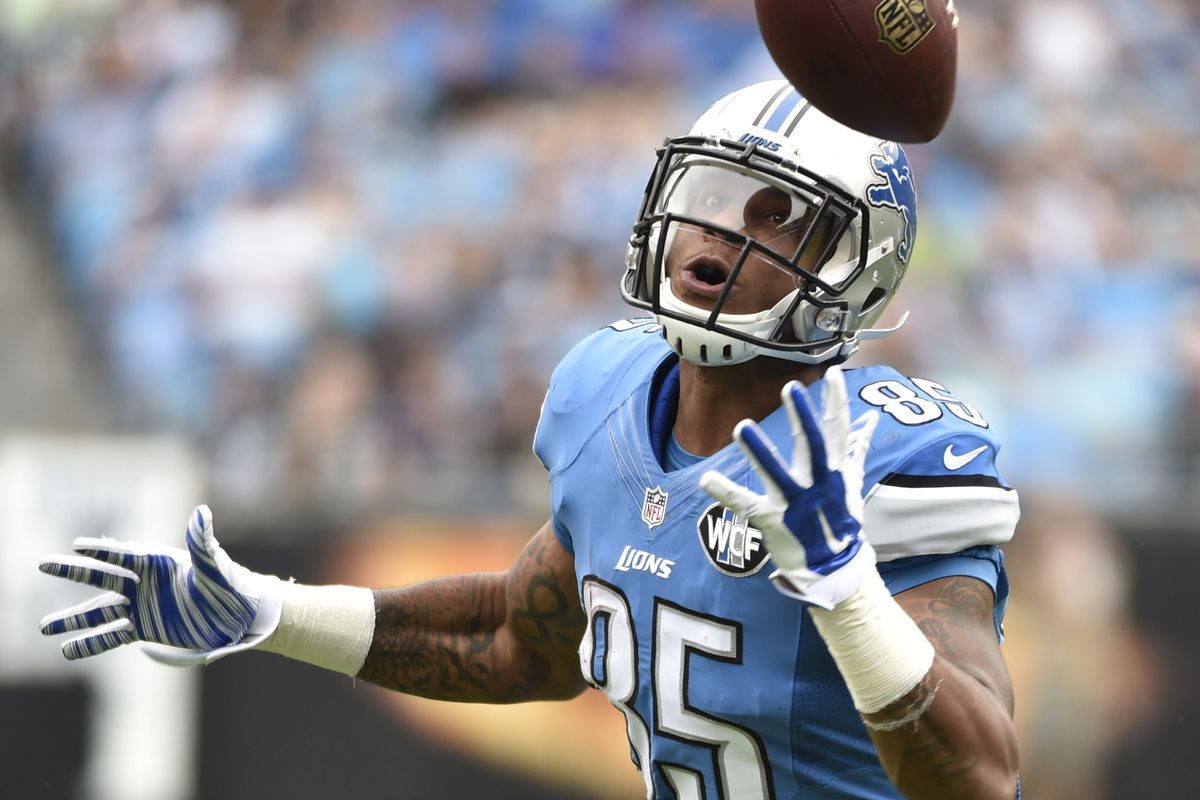
Photo Credit: Bob Donnan/USA Today Sports
The first round of the Draft is littered with tight ends whose physical and athletic traits made them solid players, but never quite the best at their positions. Kyle Brady (No. 9, 1995) had a productive career and played in three AFC Championship Games and a Super Bowl, but he played for three different teams and never earned Pro Bowl or All-Pro honors. In the 2000s, players to follow that same sort of career arc included Anthony Becht (No. 27, 2000), Jerramy Stevens (No. 28, 2002), Kellen Winslow II (No. 6, 2004), and Brandon Pettigrew (No. 20, 2009). More recent examples have included Tyler Eifert (No. 21, 2013) and Eric Ebron (No. 10, 2014).
Like any other position, there have been exceptions such as Pro Football Hall of Famer Tony Gonzalez (No. 13, 1997), former Panther Jeremy Shockey (No. 14, 2002), and – indeed – Greg Olsen (No. 31, 2007). But by and large, the first round of the Draft hasn’t been the place to find dominant tight ends. Instead, the sweet spot has generally been later in the draft.
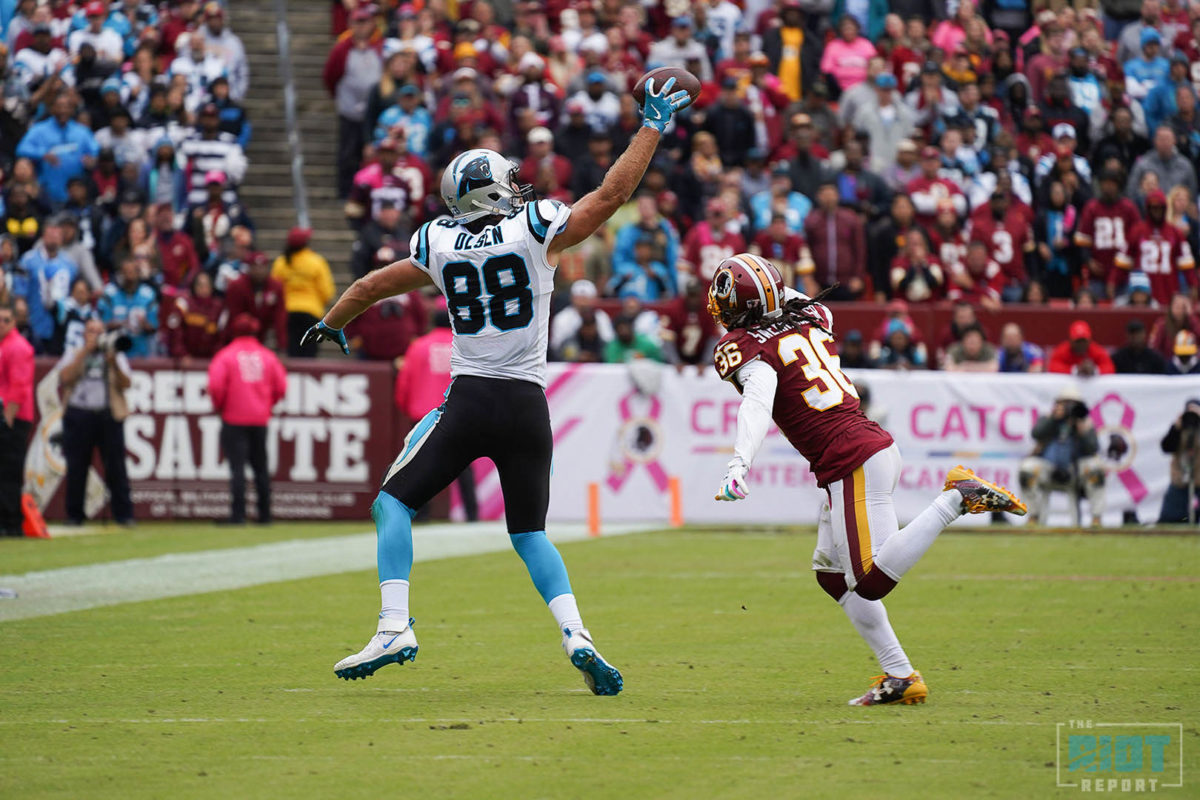
Rob Gronkowski, for instance, was the tenth pick in the second round of the 2010 Draft. Travis Kelce, meanwhile, was chosen at the start of the third round in 2013, which was also where the Cowboys found Jason Witten back in 2003, and where the Baltimore Ravens later found Pro Bowler Mark Andrews in 2018. Delanie Walker, who has enjoyed a long and productive career as a Pro Bowler and All-Pro, was a sixth-round pick in 2006. Same with Darren Waller, a Pro Bowler in 2020 who has developed into one of the best tight ends in football.
Possibly the best illustration of first-round tight ends versus more successful mid-round counterparts has come by virtue of the 2017 Draft, where three tight ends – O.J. Howard of the Tampa Bay Buccaneers, Evan Engram of the New York Giants, and David Njoku of the Cleveland Browns – were selected in the first round.
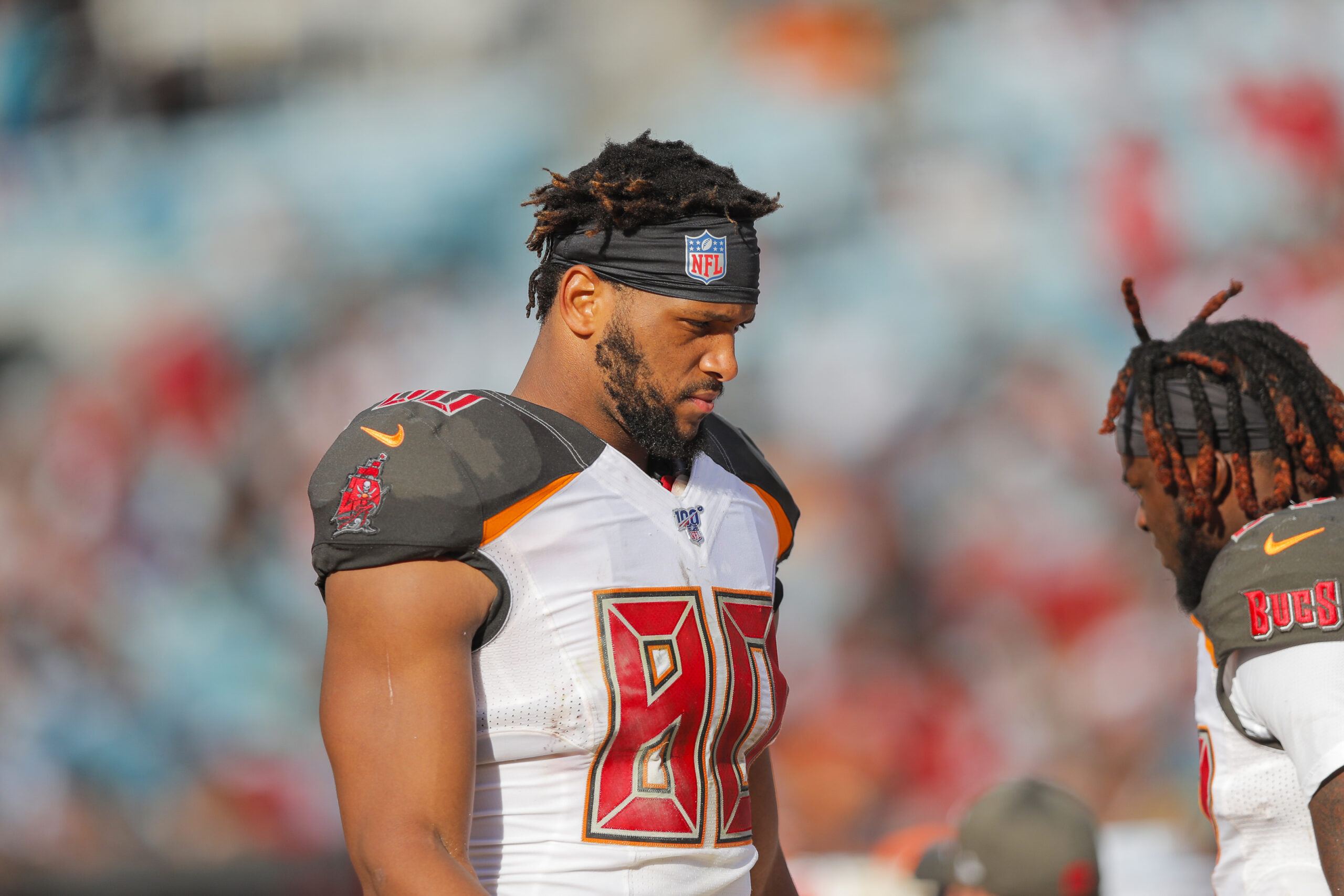
JACKSONVILLE, FLORIDA – DECEMBER 01: O.J. Howard #80 of the Tampa Bay Buccaneers looks on from the sideline during the third quarter of a game against the Jacksonville Jaguars at TIAA Bank Field on December 01, 2019 in Jacksonville, Florida. (Photo by James Gilbert/Getty Images)
Howard was the Offensive MVP of a National Championship Game at Alabama, but he hasn’t developed to the point where he’s particularly dominant by himself, instead becoming part of a three-headed monster for Tampa Bay that also features Gronkowski and Cameron Brate. Njoku looked to be ascending in 2018, but injuries over the past two years tempered his rise and he has now fallen to third on Cleveland’s depth chart. Evan Engram made the Pro Bowl in 2020 and is the Giants’ top tight end, but he has not become the player many hoped he would as he has developed a reputation for either dropping passes or tipping them to the other team.
By contrast, the Tennessee Titans ended up finding Jonnu Smith, who developed into a star tight end before leaving for the New England Patriots in free agency, with a compensatory pick in the third round. The San Francisco 49ers found George Kittle in the fifth round, and he has now become one of the elite tight ends in all of football. While this is only one draft class, this is a pattern that has sustained throughout much of recent draft history.
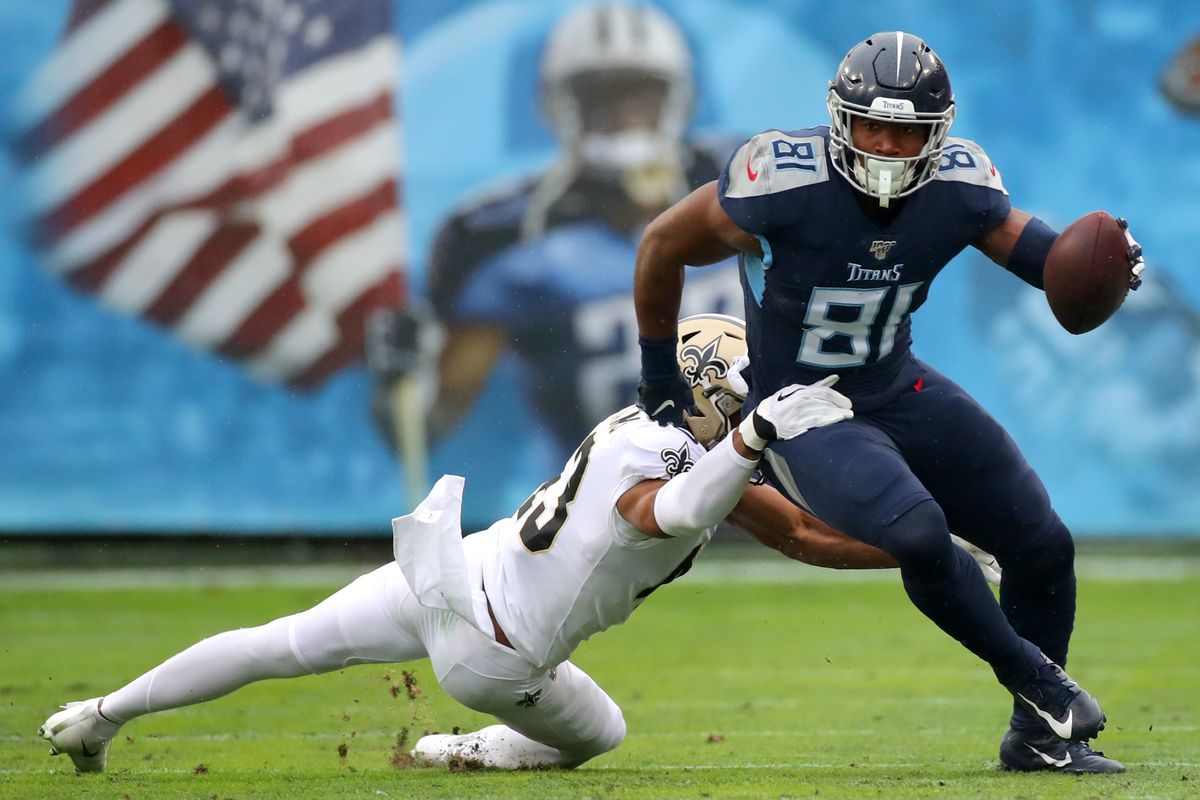
Photo Credit: Brett Carlsen/Getty Images
With this said, very few tight ends bust outright, with the likes of Derek Brown (No. 14, 1992) or David LaFleur (No. 22, 1997) being quite rare. That being the case, first round picks are ultimately not drafted because of their outright bust rate but because of how good they can become, and for NFL tight ends this seems to have less to do with physical traits than technique and how they fit into an offensive scheme.
“Some good tight ends are going to fall to Day Two and the situation in which they land is very important,” Josh Edwards of CBS Sports told The Riot Report. “George Kittle is a perfect fit in Kyle Shanahan’s system. Travis Kelce would not be as good of a fit. College usage of tight ends is really interesting too because there could be a really good pass catcher that is hidden by a team’s commitment to running the ball 50 times a game.”
“In a similar system, there could be players that are underdeveloped as a pass catcher because the coaching staff is more focused on being sound on the ground. A tight end that has not shown elite pass-catching ability is not going to be taken in the first round of the NFL Draft.”
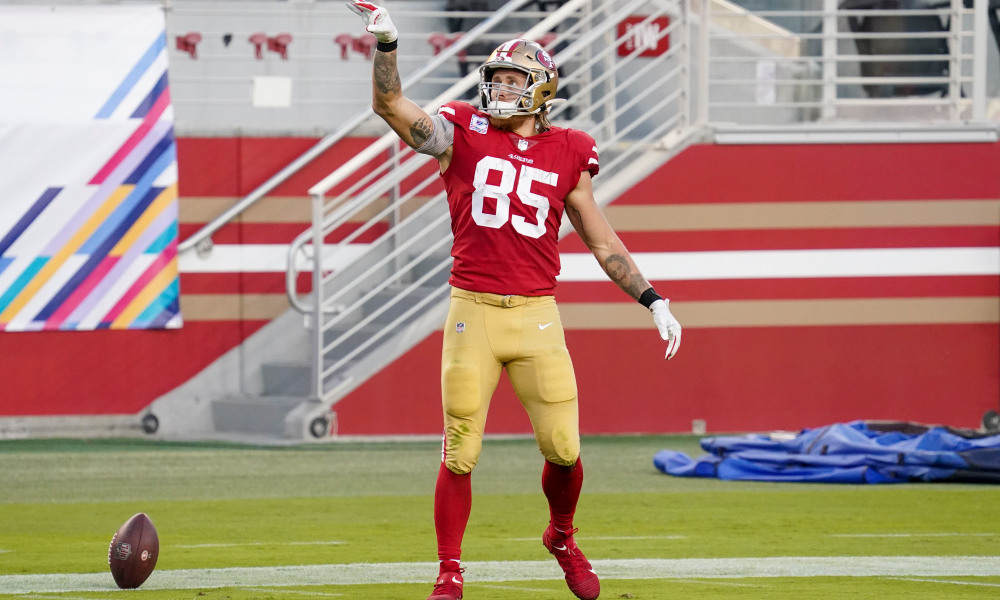
October 4, 2020; Santa Clara, California, USA; San Francisco 49ers tight end George Kittle (85) celebrates after a first down against the Philadelphia Eagles during the second quarter at Levi’s Stadium. Mandatory Credit: Kyle Terada-USA TODAY Sports
As noted in a 2018 piece by Jamison Hensley of ESPN, NFL tight ends are expected to both understand blocking schemes like offensive linemen and run routes like wide receivers. Coming out of college, most tight ends specialize in one but not the other and, in the case of many tight ends who go off the board in the first round, that specialization is generally in the passing game. This means that for almost every prospect at the position there is a significant learning curve.
While more athletic prospects might offer more upside if they are able to overcome this, ultimately athleticism isn’t an indicator of how likely they are to take that step. Importantly, how productive a player has been in college is also not a reliable indicator of how well they will translate to the NFL game.
“We put too much emphasis on productivity stats,” ESPN’s Matt Miller recently told the New York Post in regards to why top NFL tight ends fall through the cracks in the Draft. “When I evaluate tight ends now, let’s focus on traits and not production because it is so scheme-dependent.”
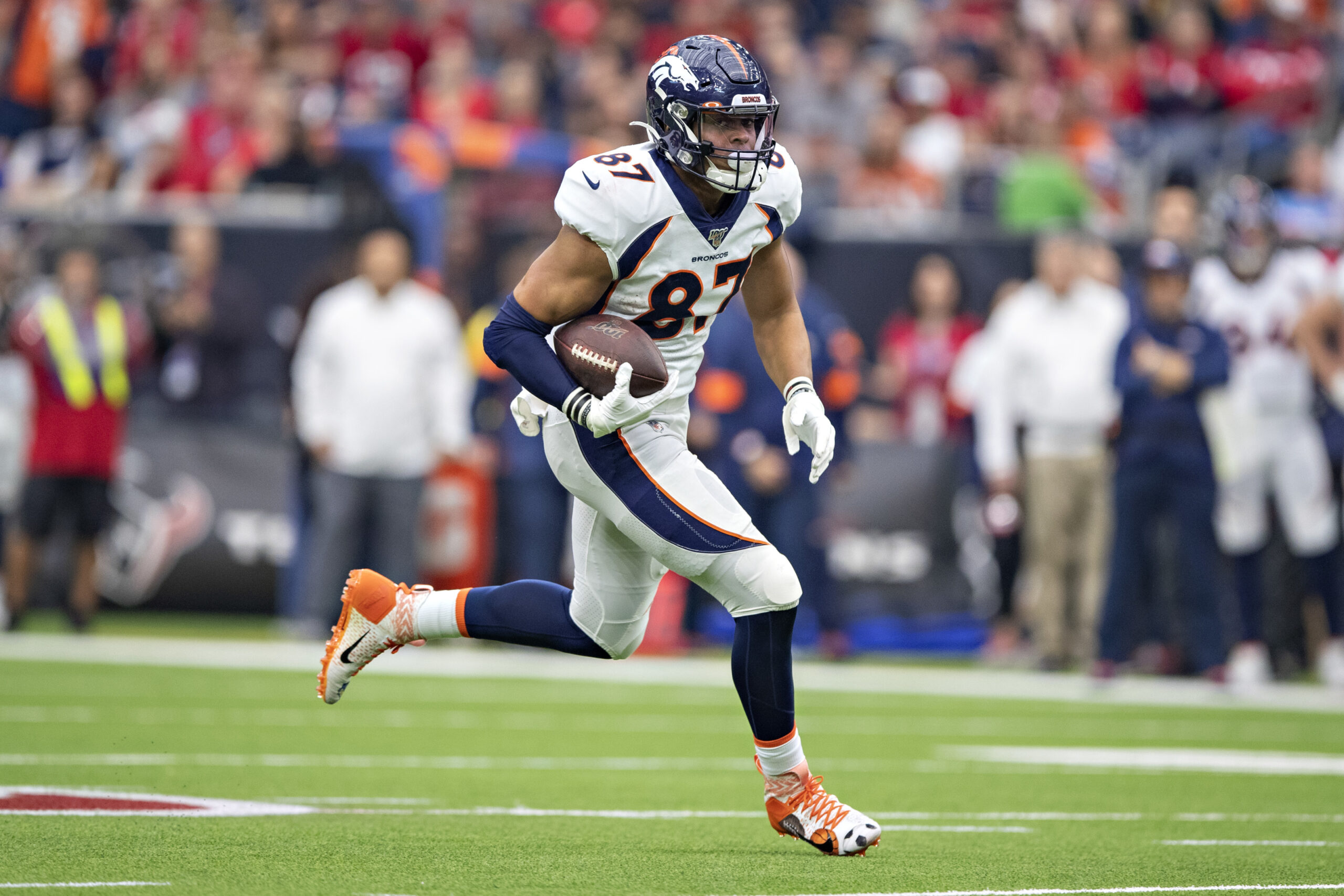
HOUSTON, TX – DECEMBER 8: Noah Fant #87 of the Denver Broncos runs with the ball in the first half of a game against the Houston Texans at NRG Stadium on December 8, 2019 in Houston, Texas. The Broncos defeated the Texans 38-24. (Photo by Wesley Hitt/Getty Images)
Ideally, the Panthers should come away from the NFL Draft with at least one more tight end. In addition to filling a void, better tight end play would go a long way towards both adding a new wrinkle to Carolina’s offense and further establishing the physical identity of Matt Rhule’s team, not to mention continuing a tradition of great Panthers tight end play established by figures like Wesley Walls and Greg Olsen.
Like any other position, however, there is a return on investment expected when a team uses a draft pick on a tight end. Generally, when it comes to tight ends, this has not been very high. This doesn’t mean that taking Kyle Pitts in the first round would definitely be a mistake, but rather that if history is any indication, then this might not be the most efficient way of addressing the position.
(Top photo via Brad McClenny-USA TODAY NETWORK)

